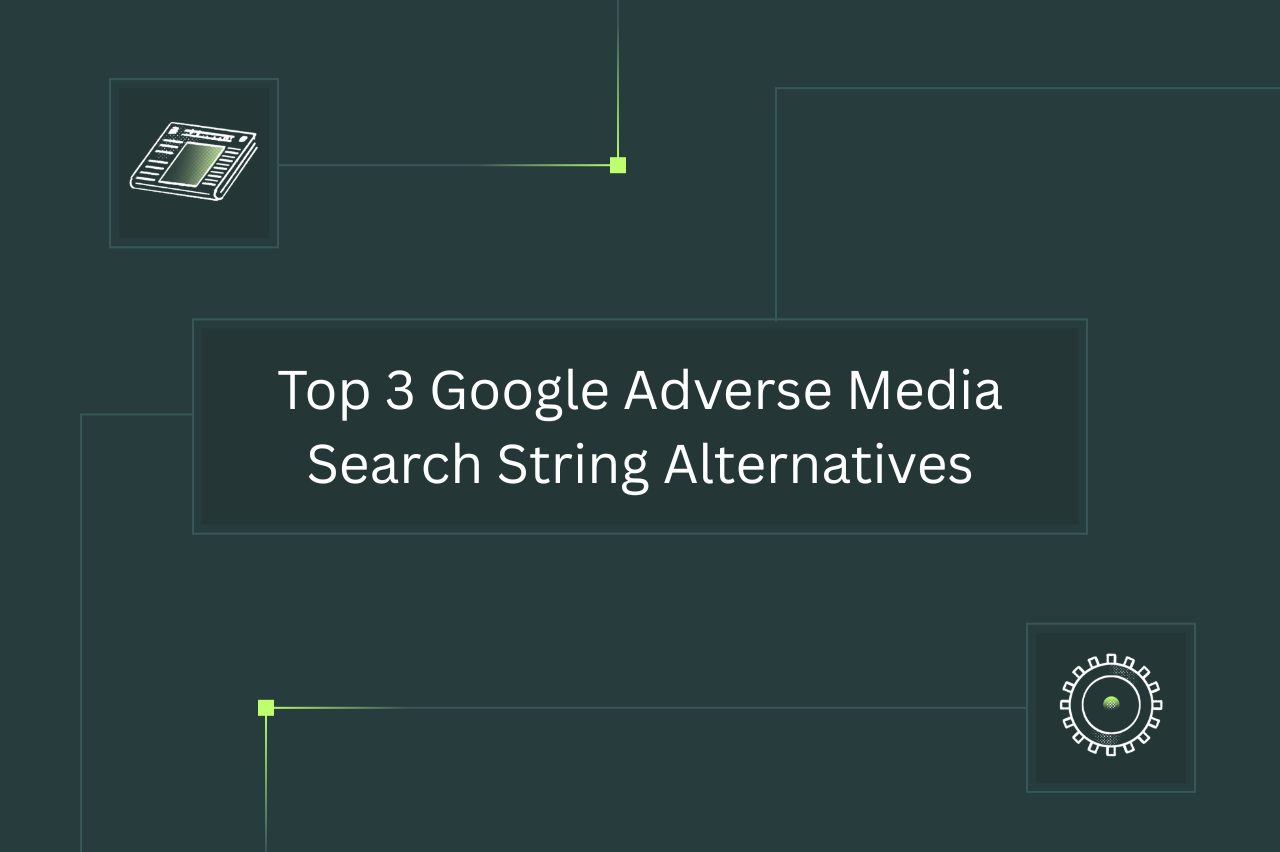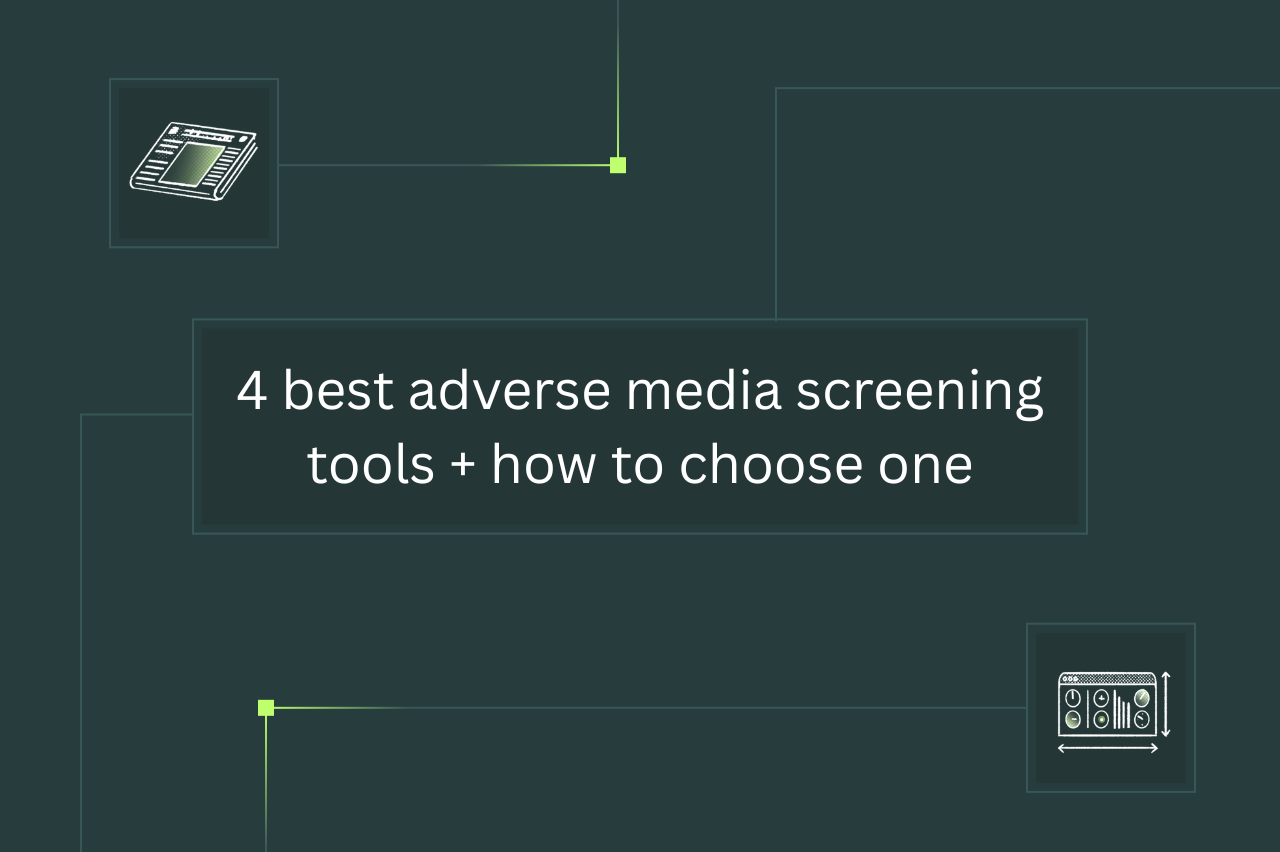In brief:
- As part of due diligence, searching for adverse media coverage on an entity can be achieved through using advanced functions on a general search engine like Google.
- An adverse media search through Google is still not a very effective due diligence technique, as the information it finds may not be thorough, precise, complete, reliable, accessible, or relevant.
- Other options include manually searching official government sources (which is slow and error-prone), building a machine learning tool (which requires lots of sample data and engineering expertise), or using a ready-made automated solution like Middesk.
Many types of businesses are required to conduct due diligence on people or business customers they are starting or maintaining professional relationships with. The purpose is to check these entities — including identifying their ultimate beneficial owners — for indications they may be unacceptably risky (illegal, even) to associate with. One of many due diligence strategies is to search for news stories that point to an entity being involved in dangerous or unlawful activities.
A simple way to look for adverse media coverage on an entity is through a generalized web search engine, such as Google. This article explains how that works in brief, as well as why it’s typically not thorough or accurate enough to meet regulatory standards. Then it offers some alternatives that better meet due diligence compliance requirements.
- How to use Google to search for adverse media
- Google adverse media search shortcomings
- Adverse media searching vs. adverse media screening
- Top 3 Google adverse media search string alternatives
{{related-content-block="/blog/adverse-media-screening"}}
First, we succinctly describe how to do a Google adverse media search.
You can use Google to search for adverse media on an entity by inputting that entity’s name, followed by keywords related to risky, unethical, or illegal behavior. You can make the search more precise by using Boolean operators; for example, using quotation marks for exact matching, “OR” to require at least one of a series of terms, and “NOT” to require the absence of a term.
A sample Google adverse media search string would be something like this:
- “Acme Corporation” terrorist financing OR money laundering OR insider trading
This would return results that contain the exact phrase “Acme Corporation”, along with any of the phrases (or variations of) ‘terrorist financing’, ‘money laundering’, or ‘insider trading’.
Using Google or another search engine may seem like a quick way to check for news of a business’s adverse behavior. But there are several pitfalls to this strategy for collecting risk-related information on a person or business customer. They include:
- It necessitates each person running one specific search at a time, and looking through one source at a time. This is highly inefficient, not to mention prone to human error.
- A search may miss variations, synonyms, or translations of risk keywords that would also point to adverse behavior, especially when using exact matching.
- The searched-for entity may be related to a case, but isn’t the one engaging in the adverse behavior (e.g. a witness, victim, or law enforcement representative). Or the entity may have the same name as a person or group involved in the case, but is itself unrelated.
- A risk keyword may not indicate adverse behavior if used in a particular context. For example, searching for “shooting” to find media coverage of gun violence may instead return results related to subjects such as sports, photography, or filmmaking.
- A search may turn up multiple adverse media hits that all refer to the same event or activity, which can make an entity look riskier than it actually is.
- The information being sought hasn't been indexed by a search engine, has restricted access (such as a paywall or account login), or was from a long enough time ago that it’s no longer relevant to the current situation.
- The information may not be completely factual. It could be a case in progress that hasn’t been fully proven, satire meant to make a political point, or outright misinformation designed to falsely damage an entity’s reputation.
While there are certain applications where this method can work, there are better options than a manual Google adverse media search for finding risk-related information on an entity. Namely, you should use tools with specialized protocols to check multiple sources at once for specific risk-related indicators. We’ll explain more about the difference next.
It can be challenging to identify at what point it’s worthwhile for you to start screening adverse media as part of your risk management strategy. And while this added feature may seem like too much to manage, having the right tool can ensure you can conduct diligent adverse media screening that can save you in the long run.
You should use adverse media screening tools with specialized protocols to check multiple sources at once for specific risk-related indicators, that can also search other databases like only web presence. Our webinar below can show you how it’s done:
{{gated-content-block="/events/webinar-bevbreak-web-dec-2024"}}
Adverse media searching is simply the process of using the advanced functions of a search engine (such as Google) to search for news and other information about an entity involved in risky conduct. However, as we demonstrated, it isn’t a very effective due diligence strategy.
It can only search a very limited number of entities and risk-related keywords at a time, and even the hits it gets aren’t guaranteed to be true positives. The searched-for entity may not be the perpetrator of the adverse behavior, or the behavior may not even be adverse depending on the terms and context involved. Or the information may not be credible, relevant, or even available.
That’s why, for the purposes of regulatory compliance in forming or maintaining business relationships, we recommend adverse media screening instead. This involves using a dedicated tool to automatically run searches on entities using thorough and specific criteria. It lets you complete more searches faster, since a computer can run multiple searches at once and analyze their results all at the same time. It also reduces the chances of encountering false positives.
Now that we’ve established adverse media screening is superior to just searching for adverse media coverage, what are some ways your business can carry it out? Here are a few examples.
1. Middesk
Middesk contains an Adverse Media add-on package that searches trusted sources for risk-related information on entities. It can screen multiple individual and business names at once, and deliver comprehensive reports in seconds.
These reports indicate adverse media hits found along with references to their sources, likely relation to the named person or business, likely relation to various risk categories, and an overall risk score for the searched entity. You don’t have to piece together contextual information yourself; instead, you can quickly assess the relevance and risk associated with the business’s media perception.
Middesk can also retrieve plenty of other information that’s useful for assessing the risk of a professional relationship with a person or business customer, so you can identify high-risk entities before they cause a problem. That includes watchlist screening, industry classifications, web footprints, litigation/bankruptcy records, and more. Our business verification makes it easy to run an OFAC check as an early indicator of a business’ compatibility.
2. Search public records from official institutions
To avoid false positives from untrustworthy sources, an organization can search for risk-related information on a person or business straight from official government (or at least government-supervised) agencies. These include courts, law enforcement, business regulators, and other institutions that have to both formally document risk-related information and make it publicly available.
However, getting this information from these institutions is usually a lengthy process — assuming they actually have the information. This, in turn, limits the number of sources an organization can efficiently search — especially if the organization has a small risk team. All of that can leave significant gaps in the coverage of what types of risk an organization can screen for. And the information itself can still be subject to human errors in interpretation.
3. Use a machine learning solution
Artificial intelligence, in combination with natural language processing, is another potential method for addressing the difficulties with adverse media screening. By identifying the most common causes of false positives, machine learning systems can devise ways to more accurately target genuine adverse media across both structured and unstructured data. This provides for a comprehensive yet non-redundant risk profile on an entity.
The downside of this approach is it takes some pretty experienced engineers, first to understand the problem and then to set up the system to solve it. It also requires a massive amount of sample data on which to train the system.
We think Middesk is the best way, but don’t let us tell you — we’ll show you. Check out our product demo for our Web Analysis tool below which can search a business’ online footprint and website for risk indicators.
{{gated-content-block="/events/productdemo-webanalysis-may-2025"}}
A Google search may be able to find adverse media coverage of a business customer (or one of its owners). However, it’s so fraught with problems of speed, accuracy, and scope that it’s a very inefficient solution. It’s better to use an automated business verification tool like Middesk to scan multiple trusted sources at once for very specific criteria. Screening for adverse media like this is far more precise, and allows for checking many entities in real-time.
Remember, though, that adverse media coverage is only one risk indicator. Fortunately, Middesk can also find many other risk signals to help your business make a proper assessment. To learn more about how we can simplify your business verification efforts, schedule a demo with our team today.











